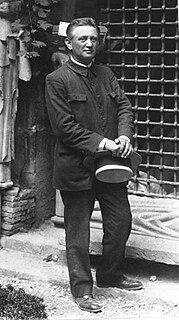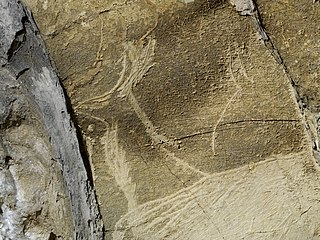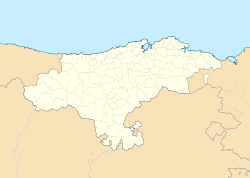
Cave paintings are a type of parietal art, found on the wall or ceilings of caves. The term usually implies prehistoric origin, but cave paintings can also be of recent production: In the Gabarnmung cave of northern Australia, the oldest paintings certainly predate 28,000 years ago, while the most recent ones were made less than a century ago.

The Cave of Altamira is a cave complex, located near the historic town of Santillana del Mar in Cantabria, Spain. It is renowned for prehistoric parietal cave art featuring charcoal drawings and polychrome paintings of contemporary local fauna and human hands. The earliest paintings were applied during the Upper Paleolithic, around 36,000 years ago. The site was discovered in 1868 by Modesto Cubillas and subsequently studied by Marcelino Sanz de Sautuola.
Cuevas or Cueva may refer to:

Henri Édouard Prosper Breuil, often referred to as Abbé Breuil, was a French Catholic priest and member of the Society of Jesus, archaeologist, anthropologist, ethnologist and geologist. He is noted for his studies of cave art in the Somme and Dordogne valleys as well as in Spain, Portugal, Italy, Ireland, China with Teilhard de Chardin, Ethiopia, British Somali Coast Protectorate, and especially Southern Africa.

Torrelavega is a municipality and important industrial and commercial hub in the single province Autonomous Community of Cantabria in northern Spain.

Cueva de La Pasiega, or Cave of La Pasiega, situated in the Spanish municipality of Puente Viesgo, is one of the most important monuments of Paleolithic art in Cantabria. It is included in the UNESCO World Heritage List since July 2008, as part of the inscription: "Cave of Altamira and palaeolithic cave art of Northern Spain."

Valles Pasiegos is an administrative comarca in Cantabria, Spain. It is formed by the valleys of the Pas and Miera rivers, each one being a natural comarca of its own.

Entrambasaguas is a small municipality located in the autonomous community of Cantabria, Spain, 25 km south of the Bay of Santander. It is moderately mountainous, and the origin of the Aguanaz River, which once drove 23 watermills and merges with the Miera River. Limestone caves with Paleolithic rock art and burial sites from the Bronze Age exist. Iron was mined here from prehistoric times, used in the Royal Artillery Factory of La Cavada, which supplied the Armada, and eventually brought some wealth during the Renaissance. First mentioned in 1210, this rural area of Green Spain consists of six towns an area of 43.2 square km, totaling about 5,000 inhabitants as of 2015, having nearly doubled since 2005.

The Cueva del Castillo, or Cave of the Castle, is an archaeological site within the complex of the Caves of Monte Castillo, in Puente Viesgo, Cantabria, Spain.

Hugo Obermaier was a distinguished prehistorian and anthropologist who taught at various European centres of learning. He is particularly associated with his work on the diffusion of mankind in Europe during the Ice Age, and in connection with north Spanish cave art, and resisted placing his science at the disposal of nationalistic and racialist interests in the Germany of the 1930s.

The Cantabrian caves' unique location make them an ideal place to observe the settlements of early humans thousands of years ago. The magnificent art in the caves includes figures of various animals of the time such as bison, horses, goats, deer, cattle, hands and other paintings. Archaeologists have found remains of animals such as bears, the remains of arrows and other material indicating a human presence; these artifacts are now found mostly in the Regional Museum of Prehistory and Archaeology of Cantabria.

The Caves of Monte Castillo, located in the Cantabrian town of Puente Viesgo, contain one of the most important Paleolithic sites in the region. The complex of karstic caves is on the slopes of Monte Castillo, a hill south of Puente Viesgo, with an elevation of 354 m. It includes four out of the eighteen caves listed as World Heritage of UNESCO since July 2008 under the title of Cave of Altamira and Paleolithic Cave Art of Northern Spain: El Castillo, Las Chimeneas, and La Pasiega and Las Monedas. In addition, the complex includes a minor fifth cave, La Flecha. The caves are located along the Pas river in the Castillo mountain, squarely at the intersection of three valleys and near the coast.

Suances is a municipality in Cantabria Province, Spain.

The Cave of Altxerri is located in the municipality of Aya (Gipuzkoa) in the Basque Country (Spain).
The Pasiega is a traditional Spanish breed of red dairy cattle from the autonomous community of Cantabria in northern Spain. It originated in the Valles Pasiegos in south-eastern Cantabria. The name derives from that of the Pas River, which flows through that region. Because of the colour of its coat it may also be known as the Roja Pasiega or Rojina.

The La Garma cave complex is a parietal art-bearing paleoanthropological cave system in Cantabria, Spain. It is located just north of the village of Omoño, part of the municipality of Ribamontán al Monte. The cave complex is noted for one of the best preserved floors from the Paleolithic containing more than 4,000 fossils and more than 500 graphical units. It is part of the Cave of Altamira and Paleolithic Cave Art of Northern Spain World Heritage Site.

Vasco-Cantabria, in archaeology and the environmental sciences, is an area on the northern coast of Spain. It covers similar areas to the northern parts of the adjacent modern regions of the Basque country and Cantabria. In geology the "Vasco-Cantabrian Basin" or "Basque-Cantabrian Basin" covers the area and the seas off the coast, in the Bay of Biscay, an area between the Iberian and European tectonic plates.

The Cave of Maltravieso in Cáceres, Extremadura, Spain, was discovered in 1951. It shows traces of human occupation from the Middle Paleolithic. It contains cave art, most notably a total of 71 hand stencils, enumerated in the 1990s using ultraviolet photography, but also linear designs and some animal paintings. In a 2018 study based on uranium-thorium dating, a hand stencil from the Cave of Maltravieso was dated to 64,000 years ago. This would make it Middle Paleolithic art, predating the presence of European early modern humans, with important implications for Neanderthal behavior.






















